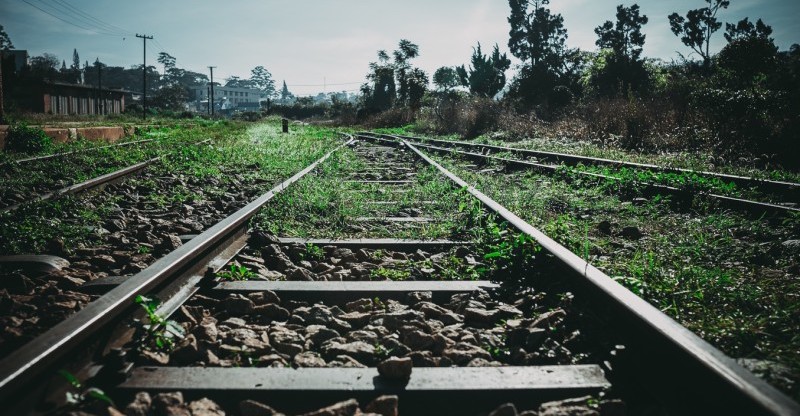We were not looking for wildlife that morning. We were looking for breakfast. Hugo was in middle school but still an early riser, so at daybreak Sunday morning we decided to walk to the new all-natural-but-still-greasy café that an enterprising lady had converted from an old lunch counter a mile or so from our apartment. There were many easier and safer ways to get there. We could have gone on the street. We could have gone down along the creek that cuts through the west side of Austin, one of our old fossil-hunting spots. We chose the way you were not supposed to go: along the railroad tracks.
Article continues after advertisement
Railroad rights-of-way are weird zones that you can find almost anywhere in the American landscape. Our urban spaces have worked to overwrite them in favor of motor vehicles in the era since World War II; often you can see the traces of tracks from old streetcar lines or intercity routes peeking through the asphalt of a public street. Sometimes the remains persist as actual ruins. Two blocks from our apartment, an old rail bridge still stood over the deep cut of Shoal Creek, overgrown with vegetation, its spurs probably not sturdy enough to support more than a couple of diminutive wanderers.
But if you stepped into its gateway, it put you on a trajectory that connected with an active rail line, where the old Missouri Pacific route comes across the river from the direction of San Antonio and cuts west for a mile or so before turning north toward Waco, DFW, and ultimately Kansas City, St. Louis, and Chicago. The remains of the old passenger station are still there and in use, where Amtrak’s transcontinental lines show up on their elusive and unreliable timetables. The stretch of right-of-way between the usually empty station and the turn north was one of those zones where time seemed a little slippery. Especially in the twilight of early Sunday morning, when the machinery of human commerce is paused.
A primal response quickly ignited deep in my brain—the recognition that it is still possible in this world for you to be some other animal’s food.
We walked along the tracks, mostly on the line not in active use, where a few rail cars were parked as easy fodder for graffiti artists. To the north were the backsides of auto repair shops, building contractors, and a lot full of old military amphibious vehicles that once put marines on the beach but had since been converted to use as river city tourist buses. Along the south side ran a narrow band of woods that graded down toward the river. In the floodplain, all the buildings that had been erected before the dams and its flood control were gone, except for one weird old wood-frame saloon still serving. It was mostly empty fields used for youth sports on the river side of the woods, as well as a YMCA and an animal shelter. You can always hear the dogs calling out from their cages, over the sound of the passing cars, though even that is quieter on a Sunday morning, the kind of morning that reminds you not all canines have adapted to survive as our servants and intermittently loved companions.
In his book The Ecology of Stray Dogs, Alan Beck documented the lives of free-ranging dogs in early 1970s Baltimore. Some abandoned, some escaped, some born free, some solitary, and others in packs. They proved to be crepuscular creatures, on the move at dawn and dusk, mostly traveling through alleys, scavenging trash, and sometimes hunting small rodents or ground birds. They sheltered in abandoned buildings and empty lots, and some of the packs made home in the urban woods.
They got their water from puddles, gutters, and in the case of one pair, a persistently leaky air-conditioning unit. In the decades since, urban renewal and enhanced animal control have mostly kept strays off the streets. Their authentically wild cousins have moved in, traveling the same pathways through the negative space of the city, hunting more than scavenging. I had been reading about their colonization of cities like Chicago and the scientific documentation of their adaptation. Seeing one while walking to breakfast, I experienced their mystery in a way statistics and maps cannot convey.
The coyote appeared in our path not far from the station, crossing the tracks, its coat of putty and quicksilver dappled in the first light that had just come up over the office buildings behind us. In the ruins, near the old steelyard full of rusting hulks, close to the spot where a few weeks earlier we had found an empty gumball machine standing in the ballast. The animal stopped right there, framed by the aperture of the right-of-way, and returned our gazes.
It was my second close encounter with a coyote. The first was walking alone in midwinter a few years earlier, in the deep country. I was tracking along the edge of a wetland that had been drained by early farmers and then remade by duck hunters with a dam of bulldozed earth, leaving an expansive marshy plain at the base of a washboard ridge that, on a cold January afternoon, was a wide sheet of ice dusted with snow. A landscape of dull crystal mutedly sparkling against the dim browns and grays of winter woods. What first caught my eye, looking north across the ice and grass as the sun hung low in the western sky, did not look like an animal at all, but a trick of the light. A shimmer, but one that was clearly suspended above the plane of the wetland.
And moving, slowly, right toward me. Like a tiny UFO, an object that seemed simultaneously material and ethereal. In my later memories, it reminded me of the spinning objects the last astronaut encounters on his journey through the infinite in Kubrick’s 2001: A Space Odyssey, or mushroom magus Terence McKenna’s description of the “self-transforming machine elves” he encountered on his first DMT trip. A mesmerizing, alien apparition leaking through some slipstream rupture in our dimensional reality.
The possibility of real danger jolted me awake, even as I quickly realized we were more dangerous to the animal than it was to us.
As it got closer, I could see that it was an animal. A canine. And I could clearly see how the silver in its coat produced that shimmer, giving it the ability to baffle the eye in the right light, especially in a winter landscape dusted with snow and ice. I realized it was a coyote. And it kept walking toward me, registering an indisputably determined hunger. It was like the feeling when a loose dog approaches you on the street, and you can’t tell whether it is coming to beg or to attack. A primal response quickly ignited deep in my brain—the recognition that it is still possible in this world for you to be some other animal’s food. It was an intense feeling.
The coyote we found behind the YMCA was not tracking us, but the feeling was similarly intense as we locked gazes for one of those brief moments of mutual threat assessment that accompanies an unexpected encounter between free canid and naked ape. Time slows when instinct activates like that and you take in every detail, registering each bit of animal motion and what it telegraphs, looking into those alien eyes of lunar yellow and trying to perceive their intention across the mostly impassable gulf of interspecies communication. The possibility of real danger jolted me awake, even as I quickly realized we were more dangerous to the animal than it was to us. A momentary window into mortality, into the wildness lurking around the edges of our carefully curated reality, and behind our deluded sense of self. I felt authentically alive.
The coyote broke the gaze and loped on its way down the alleys behind the warehouses, along the road that leads into downtown. Not to the woods, but back into the shadows of the skyscrapers where it had made its home, navigating not only through the interstitial habitat we have left for our animal neighbors, but through the even more challenging dimension of time.
As children, we learn to identify and name all the major animals, especially the ones big enough or dangerous enough to harm us or serve us and the ones cute enough to amuse us without doing either of those things. But other than the birds and the rodents and the domesticated animals we keep close by, it’s rare that we see any big wild animals outside of a zoo. The reality we have created for ourselves is designed to keep them out, for the safety of us, our children, and our food stores. This is one of the reasons why, when we do have a close encounter with a wild animal, it is a source of wonder. One of those rare moments in life when, for an instant, you feel the charge of pure instinct and experience life the way your ancestors did.
I have had many encounters with urban coyotes since then. Enough to have a sense of their diversity, their behavior, even the unique characteristics of some individuals. The variations in their color, from ghostly gray to the browns and reds of a patchwork vintage coat. Big ones and small ones, some with mange, some with permanent injuries. Individuals who stare back at me, packs that trot by in single file. Every encounter makes the next one easier to find my way into. I learn to spot their tracks, read their recency, find the remains of the food they have left behind, maybe even find their dens. I get clues as to how they live in the city, and why. Even then, such encounters are rare, relative to the time I am able to spend outside trying to make serendipity happen. But when they do happen—even if only once—staring into the eyes of another predator opens up the reality of the other world that exists beyond the simultaneously illusory and impenetrable barrier between human space and wild nature. It lets me see the city through their eyes.
__________________________________

From A Natural History of Empty Lots: Field Notes from Urban Edgelands, Back Alleys, and Other Wild Places by Christopher Brown. © Copyright © 2024 by Christopher Brown. Published by Timber Press, an imprint of Hachette Book Group. Used by permission of the publisher. All rights reserved.
